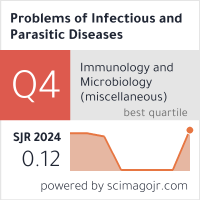DETECTION OF MEASLES AND RUBELLA ANTIBODIES IN DRIED BLOOD SPOTS
DOI:
https://doi.org/10.58395/pipd.v46i2.20Keywords:
dried blood spots, measles, rubella, ELISA assay, IgM/IgG antibodiesAbstract
This study aimed to determine the frequency of detection of measles and rubella antibodies in dried blood spots in Bulgaria.
Material and Methods: Two types of clinical material, serum samples and dried blood spots (DBS), were tested from a total of 101 patients. Serological methods (indirect ELISA) were used for detection of specific viral markers (IgM and IgG antibodies) indicating acute or past measles and rubella infection.
Results: In the present study, the patients were with median age of 39 years and divided into 11 age groups. The majority of patients were under 30 years of age and from the capital of Sofia. In 3 patients acute measles infection was confirmed by positive ELISA-IgM results for the serum samples and DBS. No acute rubella infection was detected. Measles and rubella IgG seroprevalence was determined as 83/101 (82%, 95% CI: 74.51÷89.49) and 79/101 (78%, 95% CI: 69.92÷86.08) in serum samples, and 79/101 (78%, 95% CI: 69.92÷86.08) and 73/101 (72%, 95% CI: 63.25÷80.75) in DBS, respectively. In combination with immunoenzymatic testing for measles and rubella IgM/IgG markers, coincidence of results for both types of clinical material was found in >90% of cases. No significant differences were found in the results in terms of gender and age.
Conclusion: In recent years a variety of new and innovative applications of DBS are introduced in medicine, neonatology, virology, microbiology, etc. The optimisation of the DBS technique as an alternative approach to venepuncture in virology is very important for conducting seroepidemiological studies and to a certain extent for the surveillance of epidemic outbreaks.
Downloads
References
Schmidt V. Ivar Christian Bang (1869-1918), founder of modern clinical microchemistry. Clin Chem. 1986; 32(1):213-215.
Hannon W, Therell B. Overview of the history and applications of dried blood spot samples. Dried blood spots. Applications and techniques. Li, W., Lee, M. S. VIII-IX Wiley Hoboken, 2014.
Smit P, Elliott I, Peeling R, Mabey D, Newton P. An overview of the clinical use of filter paper in the diagnosis of tropical diseases. Am J Trop Med Hyg. 2014; 90(2):195-210.
Chapman O. The complement-fixation test for syphilis. Use of patient’s whole blood dried on filter paper. Arch Derm Syphilol. 1924; 9(5):607-611.
Guthrie R, Susi A. A simple phenylalanine method for detecting phenylketonuria in large populations of newborn infants. Pediatrics. 1963; 32:338-343.
Alvarez-Munoz M, Zaragoza-Rodriguez S, Rojas-Montes O, Palacios-Saucedo G, Vazquez-Rosales G, Gomez-Delgado A, et al. High correlation of human immunodeficiency virus type-1 viral load measured in dried-blood spot samples and in plasma under different storage conditions. Arch Med Res. 2005; 36:382-386.
Demirev P. Dried blood spots: analysis and applications. Anal Chem. 2013; 85(2): 779-789.
Li W, Lee M. Dried blood spots. Applications and techniques. Li, W., Lee, M. S. VIII-IX Wiley Hoboken, 2014.
Helfand R, Cabezas C, Abernathy E, Castillo-Solorzano C, et al. Dried Blood Spots versus Sera for Detection of Rubella Virus-Specific Immunoglobulin M (IgM) and IgG in Samples Collected during a Rubella Outbreak in Peru. Clin Vaccine Immunol. 2007; 14(11):1522–1525.
Karapanagiotidis T, Riddell M, Kelly H. Detection of rubella immunoglobulin M from dried venous blood spots using a commercial enzyme immunoassay. Diagn Microbiol Infect Dis. 2005; 53(2):107-111.
Manual for the laboratory diagnosis of measles and rubella virus infection - Second edition. World Health Organization 2007.
Gatcheva N, Mihneva Z, Mehandjieva V, Petkova V. Elimination of measles in Bulgaria: the fever-rash illness surveillance revealed no indigenous transmission following the importations in 2005 and 2006. Probl Infect Parasit Dis. 2007; 35(2):30-33.
Riddell M, et al. Detection of measles virus-specific immunoglobulin M in dried venous blood samples by using a commercial enzyme assay. J Clin Microbiol. 2002; 40(1):5-9.
De Swart R, et al. Combination of reverse transcriptase PCR analysis and immunoglobulin M detection on filter paper blood samples allows diagnostic and epidemiological studies of measles. J Clin Microbiol. 2001; 39(1):270-273.
Helfand R, et al. Comparative detection of measles and rubella IgM and IgG derived from filter paper blood and serum samples. J Med Virol. 2001; 65(4):751-757.
Uzicanin A, Lubega I, Nanuynja M, Mercader S, Rota P, Bellini W, Helfand R. Dried Blood Spots on Filter Paper as an Alternative Specimen for Measles Diagnostics: Detection of Measles Immunoglobulin M Antibody by a Commercial Enzyme Immunoassay. J Infect Dis. 2011; 204:564–569.






